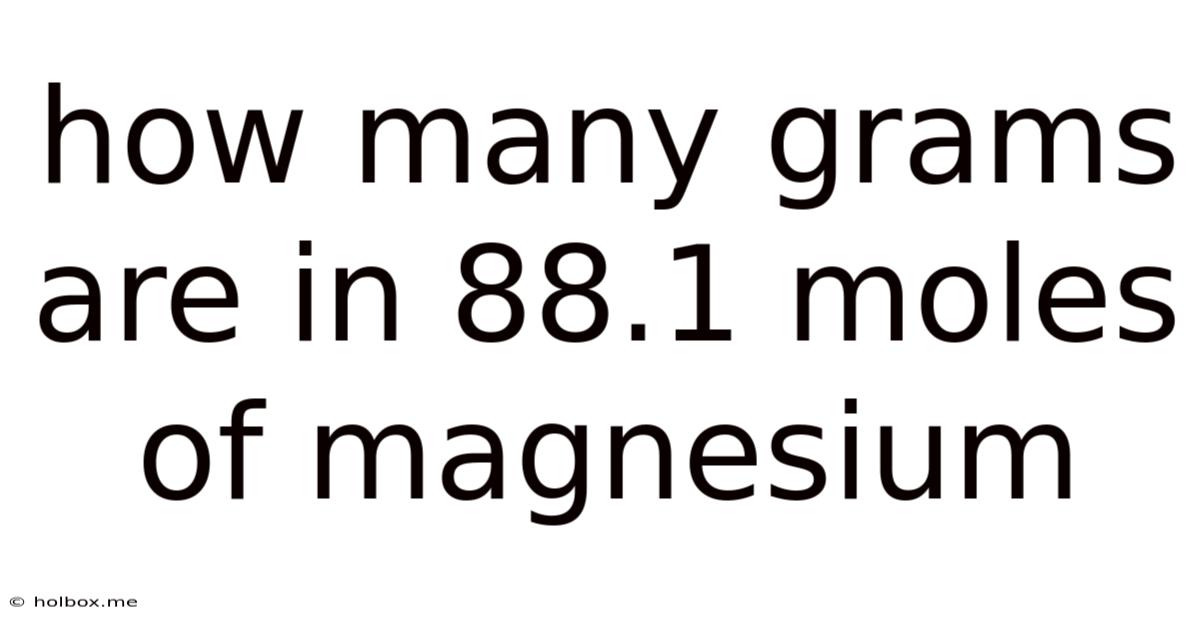How Many Grams Are In 88.1 Moles Of Magnesium
Holbox
May 08, 2025 · 4 min read

Table of Contents
- How Many Grams Are In 88.1 Moles Of Magnesium
- Table of Contents
- How Many Grams Are in 88.1 Moles of Magnesium? A Comprehensive Guide
- Understanding Moles and Molar Mass
- Calculating the Grams in 88.1 Moles of Magnesium
- 1. Finding the Molar Mass of Magnesium
- 2. Applying the Formula
- 3. Calculating the Mass
- Significant Figures and Precision
- Further Applications and Related Concepts
- 1. Stoichiometry
- 2. Solution Concentration
- 3. Empirical and Molecular Formulas
- 4. Gas Laws
- 5. Titration Calculations
- Conclusion
- Latest Posts
- Related Post
How Many Grams Are in 88.1 Moles of Magnesium? A Comprehensive Guide
Determining the mass of a given number of moles of a substance is a fundamental concept in chemistry. This guide will walk you through the process of calculating the grams in 88.1 moles of magnesium, explaining the underlying principles and providing a step-by-step solution. We'll also explore related concepts to enhance your understanding of molar mass and stoichiometry.
Understanding Moles and Molar Mass
Before diving into the calculation, let's clarify some key terms:
-
Mole (mol): The mole is the base unit of amount of substance in the International System of Units (SI). It represents a specific number of particles, namely Avogadro's number (approximately 6.022 x 10<sup>23</sup>). One mole of any substance contains Avogadro's number of particles, whether those particles are atoms, molecules, ions, or formula units.
-
Molar Mass (g/mol): The molar mass of a substance is the mass of one mole of that substance. It's expressed in grams per mole (g/mol). The molar mass of an element is numerically equal to its atomic weight (found on the periodic table) in atomic mass units (amu).
Calculating the Grams in 88.1 Moles of Magnesium
Magnesium (Mg) is a chemical element with the atomic number 12. To find the mass of 88.1 moles of magnesium, we need to know its molar mass.
1. Finding the Molar Mass of Magnesium
Consulting the periodic table, we find that the atomic weight of magnesium is approximately 24.305 amu. Therefore, the molar mass of magnesium is approximately 24.305 g/mol.
2. Applying the Formula
The relationship between moles (n), mass (m), and molar mass (M) is given by the following formula:
m = n * M
Where:
- m = mass in grams
- n = number of moles
- M = molar mass in g/mol
3. Calculating the Mass
Now, let's plug in the values we know:
- n = 88.1 moles
- M = 24.305 g/mol
m = 88.1 mol * 24.305 g/mol m ≈ 2141.6 g
Therefore, there are approximately 2141.6 grams in 88.1 moles of magnesium.
Significant Figures and Precision
It's crucial to consider significant figures when reporting the final answer. The number of significant figures in the result should match the least precise measurement used in the calculation. In this case, 88.1 moles has three significant figures, and the molar mass of magnesium (24.305 g/mol) has five significant figures. Therefore, the final answer should be rounded to three significant figures, which is 2140 g.
Further Applications and Related Concepts
Understanding molar mass and mole calculations extends far beyond simple conversions. Here are some related concepts and their applications:
1. Stoichiometry
Stoichiometry is the quantitative relationship between reactants and products in a chemical reaction. Molar mass is a fundamental tool used in stoichiometric calculations to determine the amount of reactants needed or the amount of products formed in a reaction.
For example, consider the reaction between magnesium and oxygen to form magnesium oxide:
2Mg(s) + O<sub>2</sub>(g) → 2MgO(s)
If you know the number of moles of magnesium reacting, you can use stoichiometry (along with molar mass) to calculate the number of moles and the mass of magnesium oxide produced.
2. Solution Concentration
Molar mass is essential in calculating solution concentrations, particularly molarity. Molarity (M) is defined as the number of moles of solute per liter of solution. To prepare a solution of a specific molarity, you need to know the molar mass of the solute to determine the required mass to dissolve.
3. Empirical and Molecular Formulas
Determining the empirical and molecular formulas of a compound often involves using molar mass. The empirical formula represents the simplest whole-number ratio of atoms in a compound, while the molecular formula represents the actual number of atoms in a molecule. Knowing the molar mass allows you to determine the molecular formula from the empirical formula.
4. Gas Laws
The ideal gas law (PV = nRT) utilizes the concept of moles. By knowing the molar mass of a gas, you can relate its volume, pressure, and temperature to its mass.
5. Titration Calculations
In titration, molar mass is crucial for determining the concentration of an unknown solution by reacting it with a solution of known concentration. The stoichiometry of the reaction and the molar mass of the reactants are used to calculate the unknown concentration.
Conclusion
Calculating the mass of 88.1 moles of magnesium involves a straightforward application of the formula relating moles, mass, and molar mass. However, the underlying principles of moles, molar mass, and stoichiometry are vital for a comprehensive understanding of chemistry and its applications in various fields, from materials science to medicine. By mastering these fundamental concepts, you can tackle a wide range of quantitative chemical problems. Remember to always pay attention to significant figures for accurate results. The ability to perform these calculations efficiently and accurately is a cornerstone of success in chemistry.
Latest Posts
Related Post
Thank you for visiting our website which covers about How Many Grams Are In 88.1 Moles Of Magnesium . We hope the information provided has been useful to you. Feel free to contact us if you have any questions or need further assistance. See you next time and don't miss to bookmark.